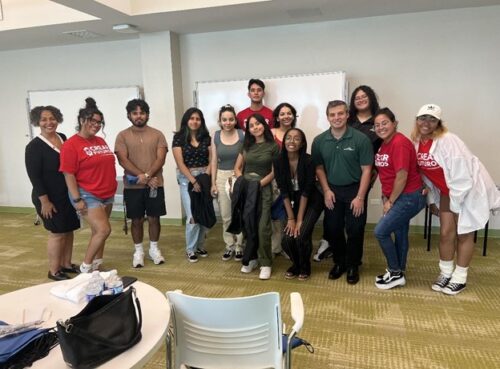Credit: Vincent Arroyo
A three person crew from Lyle Welding Fabrication of Poultney, Vermont, began construction of three towering structures by artist Del Geist, outside the Campus Center On March 18. “Cracked Ice” is the first major public art exhibition erected on the campus in over forty years.
“Cracked Ice” features three sculptures made of stone and stainless steel. “Laurentide,” the largest of the sculptures standing at 18 feet tall, is named for the Laurentide Glacier. “Muir,” the smaller sculpture with the large boulder, is named after the 19th century glaciologist John Muir. “Champlain” stands 10.5 feet tall and is named after Lake Champlain in New York and Vermont. The sculptures use ‘glacial erratic’ boulders from upstate New York.
Credit: Vincent Arroyo
In 2019, Geist came up with the idea for “Cracked Ice” because of the ongoing climate crisis.
The northern hemisphere features glaciers that expand and then recede over long periods of time. The glaciers are receding, but normally the glaciers would start to expand again. “It’s as if it were a casting of the void of an ice fracture,” Geist explained. The stainless steel in the pieces is polished to reflect a bluish hue which looks like ice.
“For me it’s a statement on climate change because it looks to me like because of human intervention, we won’t go back to a cooling period. The earth is just getting hotter and hotter,” Geist said.
Credit: Vincent Arroyo
Assistant Professor of Visual Arts and Director of the Amelie A. Wallace Gallery Hyewon Yi brought this exhibit to Old Westbury. Yi met Geist during an open studio at the Elizabeth Foundation for the Arts (EFA) in Hell’s Kitchen. Terry Connor, the director of EFA invited Yi to do a formal studio visit with eight artists; Geist was one of them.
During Yi’s visit, Geist told her that two of his sculptures were on display in the Garment District in Manhattan, but they were about to be dismantled and relocated. He said that he wanted to relocate his sculpture in a public place where the pieces can be a teaching tool. This led to the idea of presenting the sculpture here on campus.
Yi said, “I would like the viewers to reflect on the profound impacts of climate change and the forces of nature that these three public sculptures are representing and symbolizing.”
For more than forty years, Geist has integrated art into public spaces. The artist uses the natural sciences as a palette. Geist has created major site-specific artworks worldwide, including in Europe, North America, Asia, and South America. His environmental art stimulates a viewer’s sensory experience, eliciting the unique qualities of a place.
Preyia Sookram, a psychology student, said she didn’t see the sculptures as a statement about climate change, but she thought they were “unique.” A childhood education student named Samantha (who did not want her last name published) said, “I think it’s interesting.” She said the sculptures sparked a lively discussion with her friends. They each tried to figure out the meaning behind the pieces.
“We are very excited to bring ‘Cracked Ice’ to Long Island, a region whose own history began when it was carved by glacial retreat,” said SUNY Old Westbury President Timothy E. Sams.
“The presence of these works speaks to our campus’ commitment to building a more sustainable world. These sculptures will serve as a discussion and teaching point, offering all on campus the opportunity to experience the artist’s craft and consider the questions and concerns around climate change that led to his creations.”







